A Report on the Progressive Nature of Australia's Tax System vs. OECD
VerifiedAdded on 2023/06/10
|5
|696
|467
Report
AI Summary
This report analyzes the taxation system in Australia, comparing it with other member countries of the OECD, such as Denmark and Sweden. It highlights Australia's tax rate of 45% compared to Denmark's 55.8%, suggesting lower taxation in Australia promotes individual and national economic development. The report discusses how lower tax rates can motivate citizens to spend more on personal development, increase the country's GNP, and improve health and education. It contrasts this with countries like Sweden, where higher tax rates may reduce motivation to earn. The report concludes that Australia's progressive tax system, particularly with lower rates on high company incomes and higher taxes on high-income individuals, encourages economic progress and development.
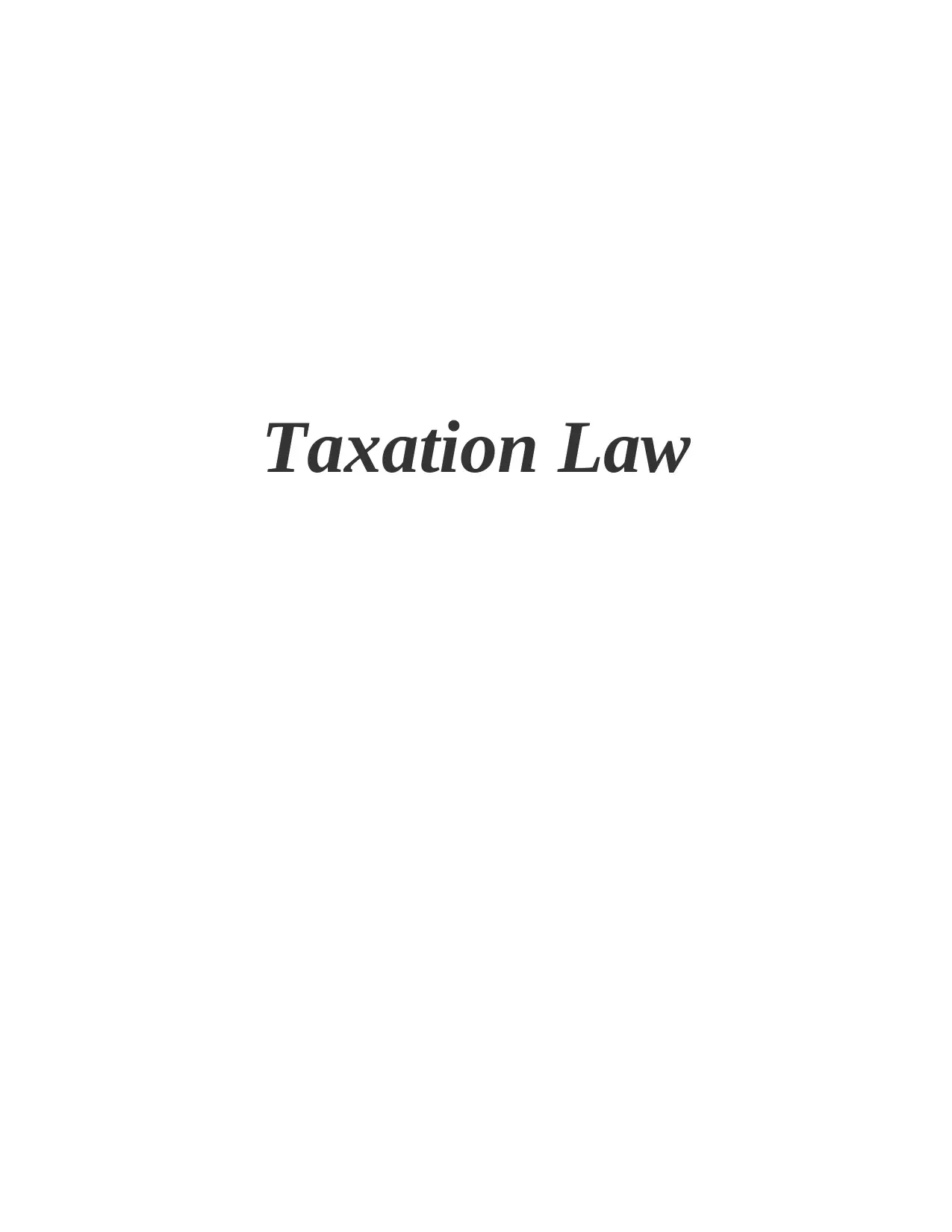
Taxation Law
Paraphrase This Document
Need a fresh take? Get an instant paraphrase of this document with our AI Paraphraser
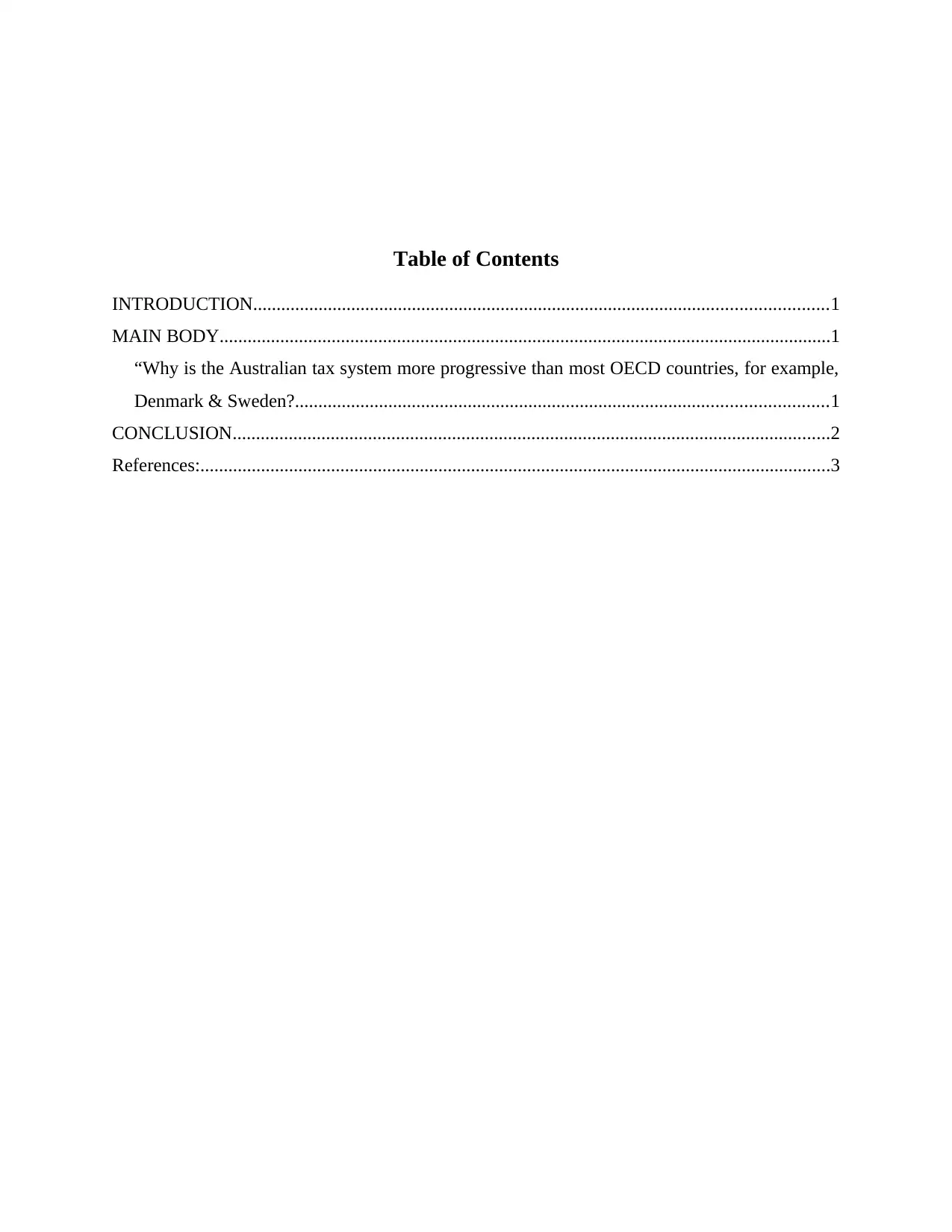
Table of Contents
INTRODUCTION...........................................................................................................................1
MAIN BODY...................................................................................................................................1
“Why is the Australian tax system more progressive than most OECD countries, for example,
Denmark & Sweden?..................................................................................................................1
CONCLUSION................................................................................................................................2
References:.......................................................................................................................................3
INTRODUCTION...........................................................................................................................1
MAIN BODY...................................................................................................................................1
“Why is the Australian tax system more progressive than most OECD countries, for example,
Denmark & Sweden?..................................................................................................................1
CONCLUSION................................................................................................................................2
References:.......................................................................................................................................3
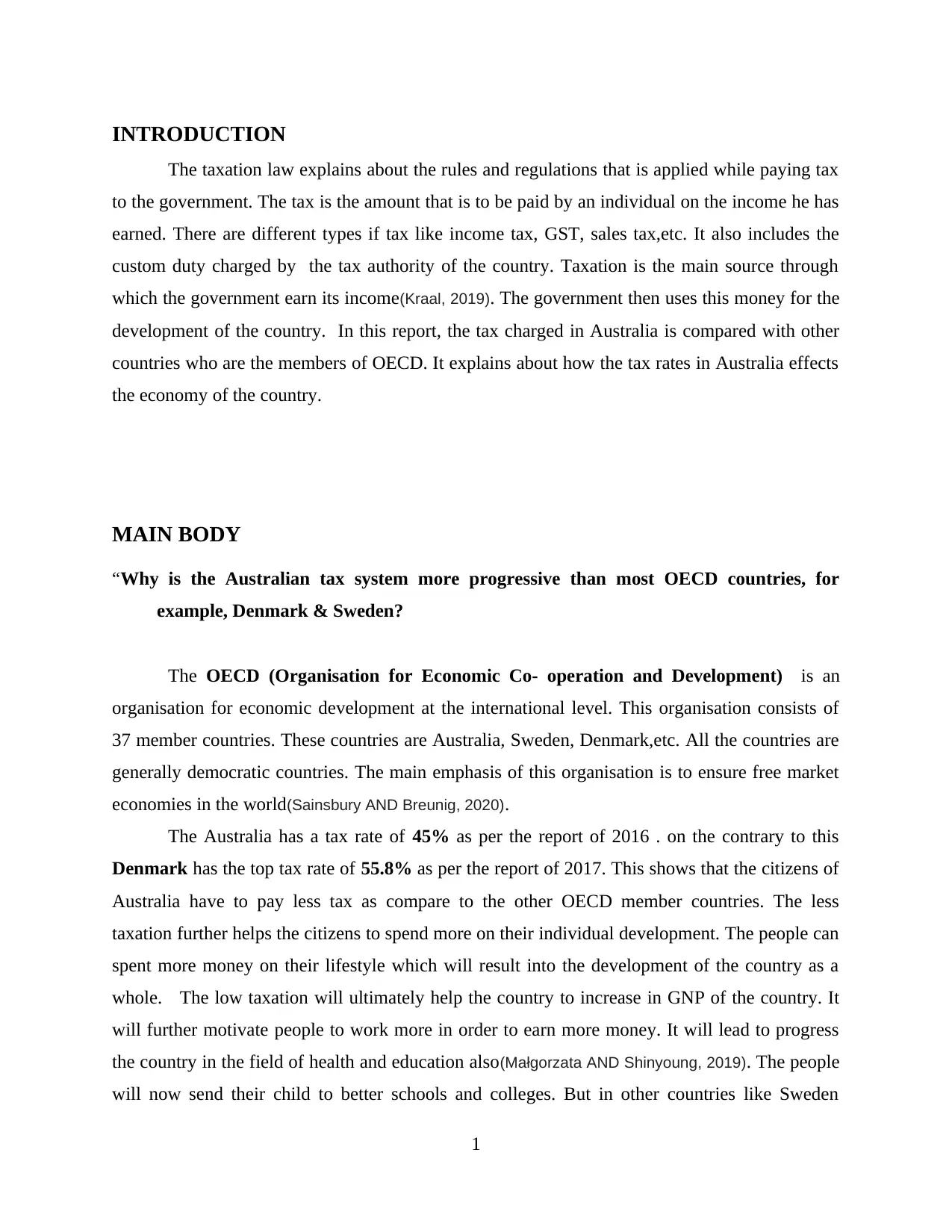
INTRODUCTION
The taxation law explains about the rules and regulations that is applied while paying tax
to the government. The tax is the amount that is to be paid by an individual on the income he has
earned. There are different types if tax like income tax, GST, sales tax,etc. It also includes the
custom duty charged by the tax authority of the country. Taxation is the main source through
which the government earn its income(Kraal, 2019). The government then uses this money for the
development of the country. In this report, the tax charged in Australia is compared with other
countries who are the members of OECD. It explains about how the tax rates in Australia effects
the economy of the country.
MAIN BODY
“Why is the Australian tax system more progressive than most OECD countries, for
example, Denmark & Sweden?
The OECD (Organisation for Economic Co- operation and Development) is an
organisation for economic development at the international level. This organisation consists of
37 member countries. These countries are Australia, Sweden, Denmark,etc. All the countries are
generally democratic countries. The main emphasis of this organisation is to ensure free market
economies in the world(Sainsbury AND Breunig, 2020).
The Australia has a tax rate of 45% as per the report of 2016 . on the contrary to this
Denmark has the top tax rate of 55.8% as per the report of 2017. This shows that the citizens of
Australia have to pay less tax as compare to the other OECD member countries. The less
taxation further helps the citizens to spend more on their individual development. The people can
spent more money on their lifestyle which will result into the development of the country as a
whole. The low taxation will ultimately help the country to increase in GNP of the country. It
will further motivate people to work more in order to earn more money. It will lead to progress
the country in the field of health and education also(Małgorzata AND Shinyoung, 2019). The people
will now send their child to better schools and colleges. But in other countries like Sweden
1
The taxation law explains about the rules and regulations that is applied while paying tax
to the government. The tax is the amount that is to be paid by an individual on the income he has
earned. There are different types if tax like income tax, GST, sales tax,etc. It also includes the
custom duty charged by the tax authority of the country. Taxation is the main source through
which the government earn its income(Kraal, 2019). The government then uses this money for the
development of the country. In this report, the tax charged in Australia is compared with other
countries who are the members of OECD. It explains about how the tax rates in Australia effects
the economy of the country.
MAIN BODY
“Why is the Australian tax system more progressive than most OECD countries, for
example, Denmark & Sweden?
The OECD (Organisation for Economic Co- operation and Development) is an
organisation for economic development at the international level. This organisation consists of
37 member countries. These countries are Australia, Sweden, Denmark,etc. All the countries are
generally democratic countries. The main emphasis of this organisation is to ensure free market
economies in the world(Sainsbury AND Breunig, 2020).
The Australia has a tax rate of 45% as per the report of 2016 . on the contrary to this
Denmark has the top tax rate of 55.8% as per the report of 2017. This shows that the citizens of
Australia have to pay less tax as compare to the other OECD member countries. The less
taxation further helps the citizens to spend more on their individual development. The people can
spent more money on their lifestyle which will result into the development of the country as a
whole. The low taxation will ultimately help the country to increase in GNP of the country. It
will further motivate people to work more in order to earn more money. It will lead to progress
the country in the field of health and education also(Małgorzata AND Shinyoung, 2019). The people
will now send their child to better schools and colleges. But in other countries like Sweden
1
⊘ This is a preview!⊘
Do you want full access?
Subscribe today to unlock all pages.

Trusted by 1+ million students worldwide
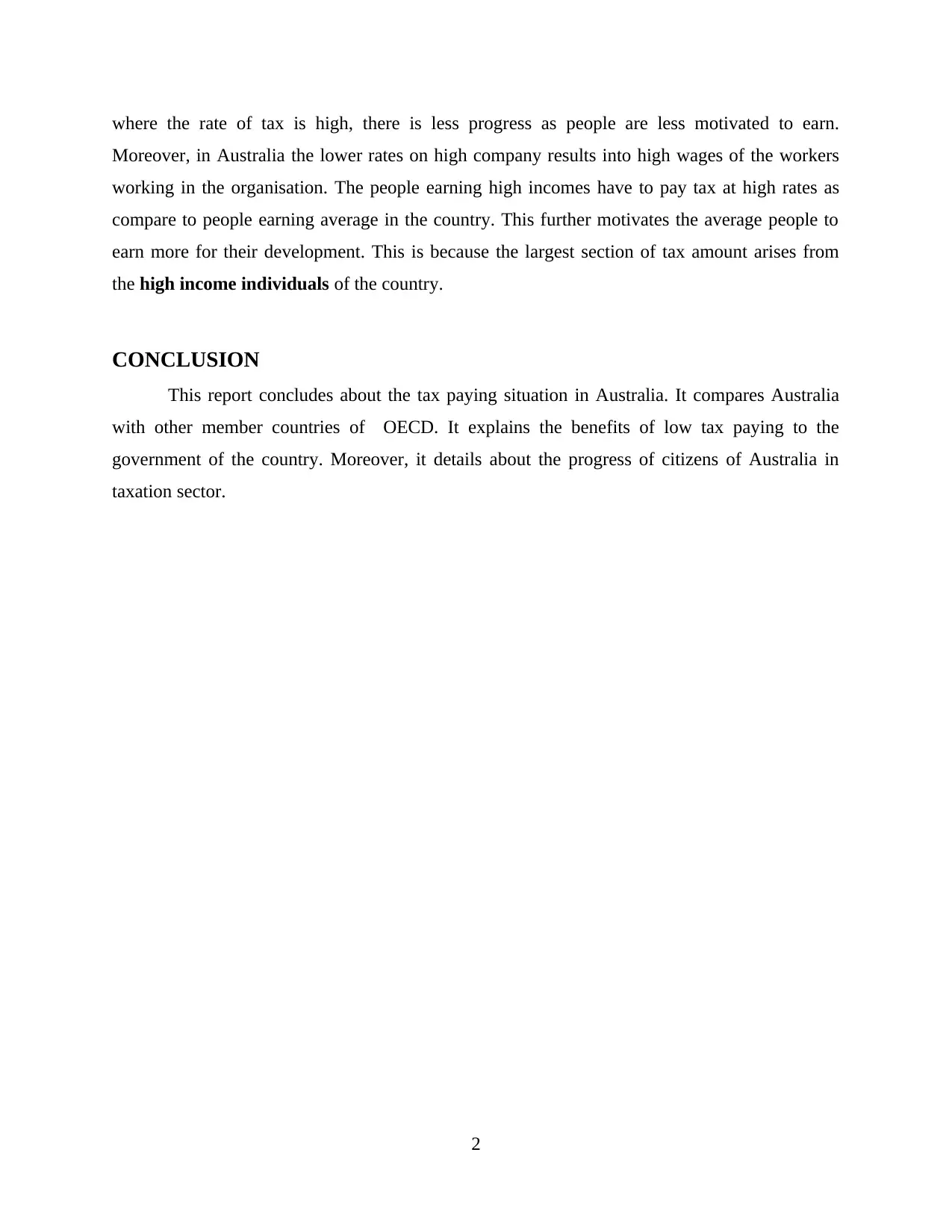
where the rate of tax is high, there is less progress as people are less motivated to earn.
Moreover, in Australia the lower rates on high company results into high wages of the workers
working in the organisation. The people earning high incomes have to pay tax at high rates as
compare to people earning average in the country. This further motivates the average people to
earn more for their development. This is because the largest section of tax amount arises from
the high income individuals of the country.
CONCLUSION
This report concludes about the tax paying situation in Australia. It compares Australia
with other member countries of OECD. It explains the benefits of low tax paying to the
government of the country. Moreover, it details about the progress of citizens of Australia in
taxation sector.
2
Moreover, in Australia the lower rates on high company results into high wages of the workers
working in the organisation. The people earning high incomes have to pay tax at high rates as
compare to people earning average in the country. This further motivates the average people to
earn more for their development. This is because the largest section of tax amount arises from
the high income individuals of the country.
CONCLUSION
This report concludes about the tax paying situation in Australia. It compares Australia
with other member countries of OECD. It explains the benefits of low tax paying to the
government of the country. Moreover, it details about the progress of citizens of Australia in
taxation sector.
2
Paraphrase This Document
Need a fresh take? Get an instant paraphrase of this document with our AI Paraphraser
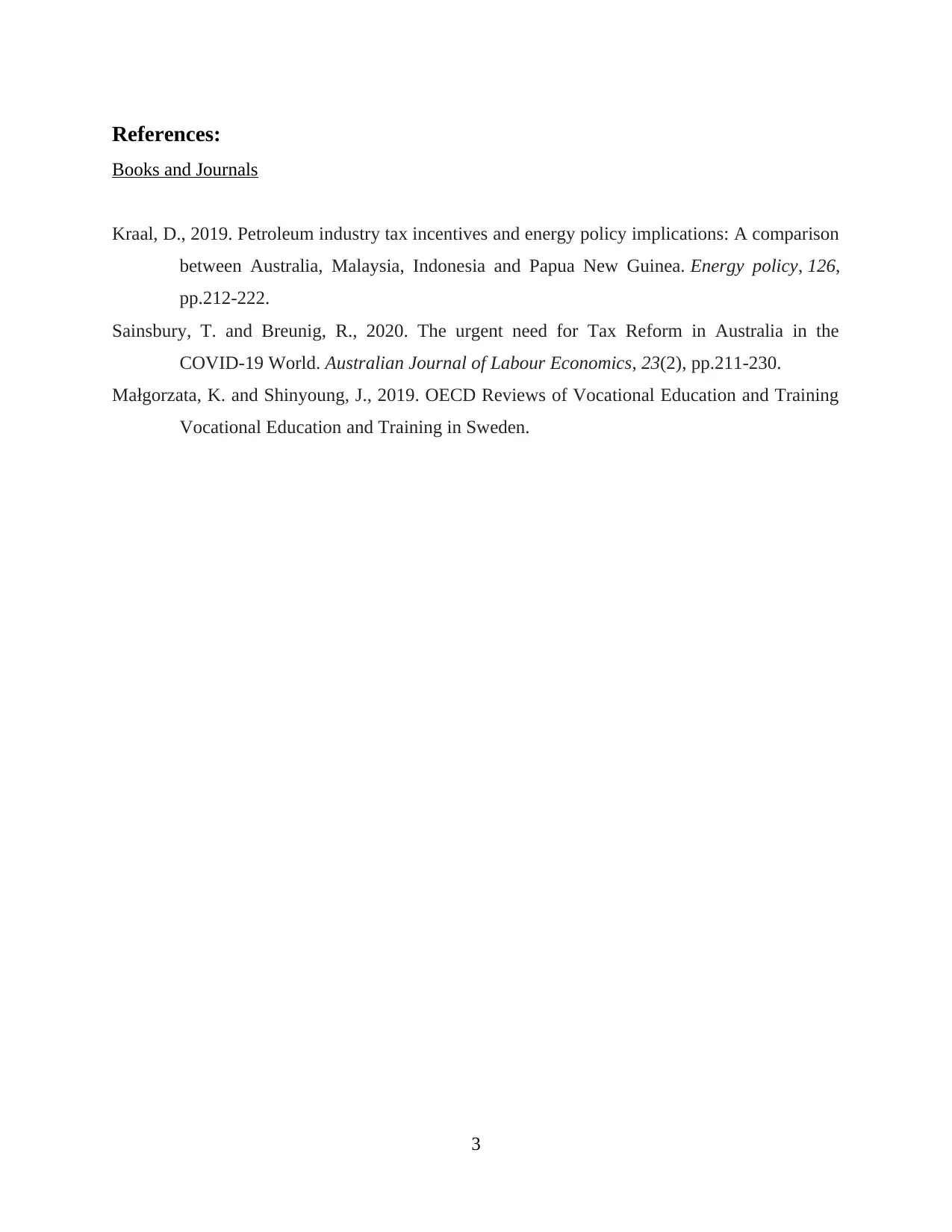
References:
Books and Journals
Kraal, D., 2019. Petroleum industry tax incentives and energy policy implications: A comparison
between Australia, Malaysia, Indonesia and Papua New Guinea. Energy policy, 126,
pp.212-222.
Sainsbury, T. and Breunig, R., 2020. The urgent need for Tax Reform in Australia in the
COVID-19 World. Australian Journal of Labour Economics, 23(2), pp.211-230.
Małgorzata, K. and Shinyoung, J., 2019. OECD Reviews of Vocational Education and Training
Vocational Education and Training in Sweden.
3
Books and Journals
Kraal, D., 2019. Petroleum industry tax incentives and energy policy implications: A comparison
between Australia, Malaysia, Indonesia and Papua New Guinea. Energy policy, 126,
pp.212-222.
Sainsbury, T. and Breunig, R., 2020. The urgent need for Tax Reform in Australia in the
COVID-19 World. Australian Journal of Labour Economics, 23(2), pp.211-230.
Małgorzata, K. and Shinyoung, J., 2019. OECD Reviews of Vocational Education and Training
Vocational Education and Training in Sweden.
3
1 out of 5
Related Documents
Your All-in-One AI-Powered Toolkit for Academic Success.
+13062052269
info@desklib.com
Available 24*7 on WhatsApp / Email
![[object Object]](/_next/static/media/star-bottom.7253800d.svg)
Unlock your academic potential
Copyright © 2020–2025 A2Z Services. All Rights Reserved. Developed and managed by ZUCOL.





